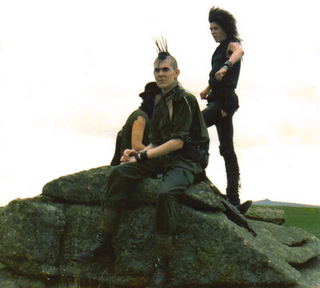
This is the seventh and final installment in my overview of the Skepticism discography. I am really getting sick of typing the name Skepticism…
Obviously, all this typing Skepticism is simply in celebration of the fact that, after five year of silence, one of my favorite bands released a new album. I had no idea why I walked over to the local punk and metal store that day. I had no money, wasn’t really in the mood for anything heavy, but for some reason I went into the shop and fingered through the new release bin. There it was, Skepticism - “Alloy”, 2008, I couldn’t believe it.
“Alloy” begins with the intensely soulful lament of “The Arrival”, which is six and a half minutes of majestic folk melodies twisting and writhing around within a down-tuned monolithic tomb of sludge. Halfway through this song, Skepticism take a quick breath before exploding into one of the most emotional and evocative passages that they’ve ever written. They could not have picked a more perfect song to open this album; it perfectly heralds a new chapter of development and growth for this band. “March October” is the second piece and it is a real bone crusher. It is built around one central palm-muted powerchord, which is an interesting minimal counterpoint to the melancholy bravado of the previous piece. Massive pipe organ clusters are sounded in unison with the open guitar chord. Eventually they build up additional melodies rhythmic constructs around this simple motif. In some ways this song does seem a little anti-climactic after the glorious opening song, but soon “March October” picks up the pace a bit and leaves the chord-crunch motif in favor of more fluid passages. The third track, “Antimony” is an organ and drum fueled raging stomp; articulate melodic patterns riding on disciplined rhythmic eruptions. Skepticism has retained the same line-up since their debut album, and all members have gained tremendously in their personality and performance on these albums. There is a wise deepening to the scope of this music. The vocalist is becoming even more expressive and intimate in his delivery. If the gain on their guitar amps wasn’t turned up so loud, the music Skepticism would seem more like an electric classical chamber ensemble rather than the clean skeleton of a heavy metal band.
“The Curtain” carries on with this aged manifestation of anthemic liberation through painful doom. The fifth track, “Pendulum” is a hypnotic and lengthy endeavor that alternates clean tone verse with heavy distorted chorus-like instrumental passages; all lead by beautiful synth string sounds… did they get a mellotron? Finally, “Oars in the Dusk” ends this album; itself a progressive doom masterpiece within a masterpiece. By the coda of this song, I felt like perhaps they saved their most dynamic and accomplished composition for the finale. The cryptic organ passages sound like they could come straight from a Vierne symphony. The song only lasts six minutes, but it somehow finds its’ way through more passages and predicaments than any other song in their repertoire.
The whole song could easily be a triumphant introduction to what will hopefully become yet another chapter in the saga of Skepticism.






























